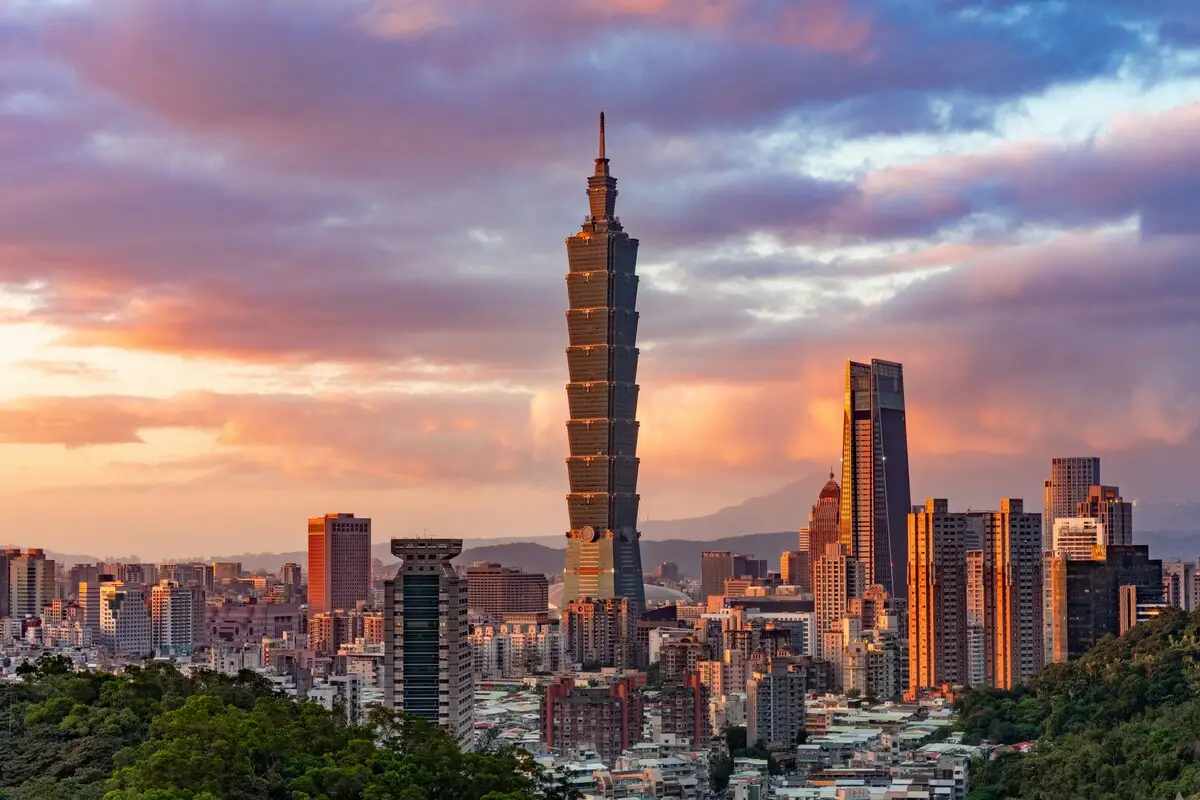
Taiwan is an island of contrasts and charm. Its name evokes misty mountain peaks, bustling night markets, and a culture that thrives effortlessly between tradition and modernity. Once a relatively overlooked destination in Western media, Taiwan has emerged as a magnetic hotspot for travellers seeking both natural beauty and urban sophistication, a true sensory feast for those willing to explore.
Step into a place where neon lights meet centuries-old rituals, where scooters zip past lush landscapes, and fragrant street food fills the air. Taiwan invites its guests to slow down and savour its flavours, its scenery, and its people.
Defining Taiwan
Before you arrive, it’s worth addressing a common misconception: Taiwan is not just “part of China”. Officially called the Republic of China, Taiwan has its own government, economy, and cultural identity shaped over centuries. Indigenous heritage, Chinese migration, Japanese colonisation, and modern democratic developments have created a uniquely Taiwanese society, making the island as complex as it is captivating.
Stories etched in every corner of Taiwan
Taiwan’s story stretches back thousands of years, from indigenous civilisations to Dutch and Spanish trade outposts in the 17th century. Chinese settlers arrived in waves, leaving deep cultural roots that still echo in temple festivals, cuisine, and language. Japanese colonisation in the early 20th century brought modernisation, while post-1949 developments transformed Taiwan into a resounding democratic society. Today, every street, market, and mountain trail reflects these layers, making Taiwan a living mosaic of history and culture waiting to be explored.
Before you go, remember these
Taiwan may be densely populated, but nature is never far away with the available green spaces. Nearly 60 per cent of the island is covered in forests and parks, showcasing scenic hikes and serene escapes just a short ride away. For example, Taiwan’s volcanic geology provides numerous hot springs.
Temples are everywhere, blending Buddhist, Taoist, and local folk traditions. Respect local customs by entering on the right and exiting on the left. Speaking of respect, tipping is not customary in Taiwan (except for tour guides) and may be considered impolite elsewhere.
Moreover, scooters dominate city streets, normally silently weaving through traffic. Stay alert when crossing roads in dense urban areas.

Touch down in Taipei
Most international flights land at Taoyuan International Airport, located about 40 kilometres west of Taipei, while a smaller number arrive at Songshan Airport, conveniently found in the city. Taiwan’s national airline, EVA Air, serves both airports, alongside a wide selection of international carriers. Both airports are seamlessly connected to the city via the Taipei Metro, making your transfer into town easy and stress-free.
The Taoyuan Airport MRT, nonetheless, is the simplest way to reach central Taipei for first-timers. A one-way ticket to Taipei Main Station costs NT$160 and is both fast and reliable. You can even tap your international card at the entry gate instead of fumbling for cash if you’re in a rush. Taxis and buses are also readily available for those seeking a bit of flexibility, carrying heavy luggage or in a group.
Staying connected with EasyCard and SIM Cards
An EasyCard is your new best friend in Taiwan. This little plastic card can be used for almost all public transport, taxis, and even convenience stores like 7-Eleven, making it a must for first-timers. EasyCards are sold at the airport, most convenience stores, or online in advance. In southern Taiwan, the iPass works similarly and is widely accepted as well.
Staying connected is effortless, too. SIM cards and eSIMs are available at kiosks in both Taoyuan and Songshan Airports, where you can enjoy unlimited data and optional local numbers. For instant connection upon arrival, eSIMs like MobiMatter are a convenient choice. Portable Wi-Fi routers are available for hire as well, if you prefer.
Download a few necessary apps to make your Taiwan trip easier:
1. Food Panda – for convenient food delivery around Taipei.
2. Go! Taipei Metro – for navigating the subway system.
3. Google Maps or Citymapper – for precise directions.
4. Google Translate – essential for small local eateries without English menus.
5. Taiwan High-Speed Rail app – for schedules and updates.
6. TRA app – for local train routes.
7. Taiwan Weather – for accurate, up-to-date forecasts.
Getting around Taipei and beyond
Taipei is a city built for exploring. The MRT and bus network are efficient, inexpensive, and beginner-friendly. Staying near an MRT station is highly recommended, as it makes accessing the city’s highlights a breeze. For shorter trips or off-the-beaten-path explorations, Uber and local taxis are safe, affordable, and easy to book.
Venture further afield with Taiwan’s High-Speed Rail (HSR), which opens up the island for day trips. From Taipei, you can explore Wulai with its hot springs or hop on the Pingxi Line to visit charming towns like Houtong Cat Village and Shifen Waterfall.
Taipei neighbourhoods to consider
So you decided to stay in Taipei for much longer. Choosing the right neighbourhood can transform your visit. Here’s a quick overlook:
- Beitou: Hot spring capital with lush greenery, 20 minutes from downtown MRT.
- Dadaocheng and Datong: Rich in history, Dihua Street markets, and mid-range hotels.
- Daan: Central location, great for parks and food streets like Yongkang Street.
- Dalongdong: Quiet neighbourhood, near Taipei Expo Park and Maji Square.
- Gongguan and Longquang: Off the tourist radar, student-populated, quirky cafes.
- Shilin: Famous for the night market and cultural attractions like the National Palace Museum.
- Tamsui: Riverside charm with historic port ambience, riverside hotels, and local food.
- Ximending: Central, lively with shops, night markets, and transport links.
- Xinyi: The city’s business hub, home to Taipei 101, shopping malls, and plenty of chain restaurants.
- Zhongshan: Hip cafes, vintage stores, and the trendiest hangouts.
- Zhongzheng: Budget-friendly, near Taipei Main Station, convenient for transport.
Tasting authentic Taiwan
Taiwan vows to never let you go hungry. Go to the bustling night markets or the elegant tea houses, and you’ll understand why Taiwan is a food lover’s paradise.
Night markets are the beating heart of Taiwanese street food. Even if you skip exotic selections, vegetarian options abound, including fried scallion pancakes to peanut ice cream rolls. The energy, aromas, and lively crowds make every visit unforgettable. Cash is king, as small vendors and night markets usually prefer cash, so a few thousand NTDs go a long way.
Vegetarian food is surprisingly easy to spot since bout 13 per cent of Taiwanese follow a vegetarian diet, influenced by Buddhist traditions, where dishes are often marked with 素. Asking “Zhe shi su de ma?” (“Is this vegetarian?”) will help navigate menus with confidence.

As the birthplace of bubble tea, Taiwan is where you must try this iconic drink. Explore local tea shops and tea farms to appreciate the full spectrum of Taiwan’s tea culture, such as green tea and fermented black teas.
Ubiquitous convenience stores like 7-Eleven and FamilyMart are also perfect for tea eggs, snacks, mobile data, and topping up your EasyCard for public transport. Quick bites and practical errands are effortlessly handled here.
Below are some must-try local specialities:
1. Beef noodle soup: Tender beef in a rich, aromatic broth.
2. Oyster omelettes: A crispy, savoury-night-market classic, particularly popular at Ningxia Night Market.
3. Peanut ice cream rolls: A quirky dessert of crushed peanuts and ice cream wrapped in a thin crepe.
4. Pineapple cake: Sweet pastry treats that make for the ultimate Taiwanese souvenir.
5. Scallion pancakes: Crispy, flaky, and perfect for a snack on the go.
6. Stinky tofu: A bold, fermented treat served fried or steamed, usually accompanied by pickled cabbage.
7. Tea eggs: Brown-spiced eggs sold in convenience stores.
8. Xiao Long Bao (soup dumplings): Delicate dumplings filled with savoury broth.
What to buy in Taiwan?
Taiwan presents both edible and lasting mementoes:
1. Souvenir stamp book: Collect stamps from cities and attractions across Taiwan.
2. Bubble tea carriers: Functional and fun souvenirs.
3. Bugcat Capoo merchandise: The six-legged blue cat is a cult favourite.
4. Kavalan Whisky or Kuai Kuai snacks: A taste of local flavour.
5. Pineapple cakes: ChiaTe is widely celebrated as the best.
6. Tea sets: Elegant reminders of Taiwan’s tea culture.
5 iconic sites to visit in Taiwan
Your Taiwan trip won’t be complete without some sightseeing. These five iconic destinations capture the essence of Taiwan, each opening a window into its rich landscapes, history, and traditions.
Beitou Hot Springs
Beitou is a sensorial delight: the scent of sulfur mingles with the soothing warmth of steaming pools. Hot spring bathhouses range from traditional wooden structures to spa-like modern retreats, while the surrounding park and geothermal museum reveal the neighbourhood’s rich history. A quick MRT ride from central Taipei drops you into a world of relaxation; for a quieter experience, visit on a weekday and linger in the mineral-rich waters, letting the heat and calm wash over you.
Jiufen Old Street
Perched on misty hillsides is Jiufen, where you’re transported to a storybook village as every winding alley reveals a new delight. Steam curls from street food stalls selling sweet taro balls and herbal teas, while red lanterns sway gently above teahouses that have been welcoming travellers for decades. To capture the quiet charm before the crowds descend, arrive early via bus from Ruifang Station, sip tea overlooking the mountains, and let yourself get lost in the narrow lanes, discovering tucked-away shops and local artisans along the way.

Taipei 101 and Xinyi District
Rising like a glass-and-steel beacon above the city, Taipei 101 is impossible to miss. Step onto the observation deck, and the sprawling metropolis stretches beneath you, mountains framing the horizon as scooters hum along the streets below. Around the tower, Xinyi District pulses with energy—luxury boutiques glimmer beside cosy cafes and hidden cocktail bars. For a local touch, wander the side streets, ducking into art galleries or stopping for a perfectly brewed cup of oolong. The MRT drops you right at Taipei 101, making it effortless to combine sightseeing with a taste of the city’s chic modern culture.
Taroko Gorge
Taroko Gorge is where Taiwan’s rugged beauty takes your breath away. Towering marble cliffs rise above turquoise rivers, and hidden waterfalls cascade down moss-covered rocks. Trails vary from gentle walks to heart-pumping hikes, each revealing secret temples or cave shrines etched into the mountains. The train from Taipei to Hualien is scenic in itself, and once you arrive, it’s impossible not to feel dwarfed by nature’s grandeur—a raw, unforgettable reminder of Taiwan’s wild side.
Sun Moon Lake
Sun Moon Lake is a tranquil expanse where misty waters mirror lush mountains. Cycling along the lake’s edge, taking a serene morning boat ride, or wandering the nearby Aboriginal villages gives an intimate sense of place. Accessible by bus or car from Taichung, the lake is a haven for slow, reflective travel—here, mornings are for gentle paddling, afternoons for photographing the sunlight glinting off the water, and evenings for savouring local delicacies at a lakeside eatery.
When is the best time to visit Taiwan?

The ideal time to explore Taiwan is in the fall (October–November), winter (December–February), or spring (March–May). Summer can be intensely hot and humid, while fall is brimming with crisp skies and colourful foliage. Winter brings mild temperatures and the festive charm of the Lunar New Year celebration.
February is also the month of the Lantern Festival, when glowing lanterns illuminate the night sky. Spring, on the other hand, is perfect for cherry blossoms, which bloom earliest in the south from January. Rain is heaviest in August and September, while the Lunar New Year in February sees crowds and peak accommodation prices in popular spots like Jiufen and Sun Moon Lake.
Either way, the weather can vary greatly. Northern regions are subtropical, while southern areas lean tropical. Pack layers, an umbrella, and avoid typhoon season (June–September) for a smoother trip.




 Mirella Pandjaitan
Mirella Pandjaitan
 Nov 12, 2025
Nov 12, 2025